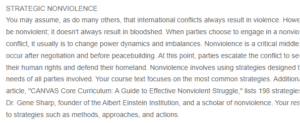The Power of Nonviolence- Bridging Negotiation and Peacebuilding
Selected Country: Liberia
Countries use various strategies to restore and maintain peace. According to Schirch (2004), the main peacebuilding strategies include waging conflict in non-violent ways, transforming relationships, reducing direct violence, and building capacity. Liberia is one of the countries that use non-violent strategies to build peace. Liberia created a truth and reconciliation commission to promote security, national peace, reconciliation, and unity (Amnesty International, 2021). The main role of the commission is to investigate the violations of human rights, human rights abuse, and the violations of international humanitarian law that happened between October 14, 2003 and January 1979.
The main strategy embraced by the Truth and Reconciliation Commission in building peace in Liberia includes reducing direct violence and transforming relationships among the people living in Liberia. For instance, the commission has prosecuted the people accused of various crimes in the country, such as crimes related to the violation of human rights, leading to a state of calmness in the country. However, the commission’s efforts have not been so successful because people are afraid to speak up (Amnesty International, 2021). Therefore, the country needs to consider other approaches, such as building capacity to encourage public participation in preventing violence.
The strategy applied in Liberia can also be applied in other countries, such as Iraq, to deal with violence because the violence in Iraq is related to the violation of human rights. For instance, Iraq can form a commission to investigate the people accused of committing violence against human rights and take necessary action, such as prosecuting them to deter people from committing violent crimes. Iraq can also use a reconciliation commission to unite conflicting tribes to prevent violence against each other, leading to overall peace restoration in the country.
References
Amnesty International. (2021, August 17). Liberia: Violence, discrimination and impunity. https://www.amnesty.org/en/documents/afr34/003/2005/en/
Schirch, L. (2004). The little book of strategic peacebuilding. Good Books.
ORDER A PLAGIARISM-FREE PAPER HERE
We’ll write everything from scratch
Question
STRATEGIC NONVIOLENCE
You may assume, as do many others, that international conflicts always result in violence. However, conflict can be nonviolent; it doesn’t always result in bloodshed. When parties choose to engage in a nonviolent approach to conflict, it usually is to change power dynamics and imbalances. Nonviolence is a critical middle phase that may occur after negotiation and before peacebuilding. At this point, parties escalate the conflict to secure or attain their human rights and defend their homeland. Nonviolence involves using strategies designed to satisfy the needs of all parties involved. Your course text focuses on the most common strategies. Additionally, the assigned article, “CANVAS Core Curriculum: A Guide to Effective Nonviolent Struggle,” lists 198 strategies suggested by Dr. Gene Sharp, founder of the Albert Einstein Institution, and a scholar of nonviolence. Your resources also refer to strategies such as methods, approaches, and actions.

The Power of Nonviolence- Bridging Negotiation and Peacebuilding
To prepare for this Discussion:
Review Chapter 6 in your course text, The Little Book of Strategic Peacebuilding, and pay particular attention to the map of peacebuilding.
Review Chapter 7 in your course text, The Little Book of Strategic Peacebuilding. Focus on strategies of nonviolence.
Review the assigned pages in “CANVAS Core Curriculum: A Guide to Effective Nonviolent Struggle.” Consider the methods of nonviolent action, Gene Sharp’s list of 198 nonviolent actions, and the overview of nonviolent conflict in Serbia.
Review the article, “Recognizing the Power of Nonviolent Action.” Pay particular attention to the section titled, “Nonviolent Movements Against Governments Opposed by the United States.”
Review the assigned pages in the article, “Why Civil Resistance Works.” Take note of each case study, and pay attention to the systems and approaches used in each country.
Select a country from your assigned Learning Resources that has experienced success with nonviolent strategies.
Consider two nonviolent strategies that the country used and why they were successful.
Think about how the strategies might be successful in another country/conflict.
With these thoughts in mind:
Post a brief description of the country that you selected. Explain two nonviolent strategies that it used. Explain how and why each strategy was successful in that country and how and why it might be useful in another country or conflict. Be specific.
Note: Include the name of the country that you selected in the first line of your post. You will be asked to respond to a colleague who discussed a different country than the one that you did.

